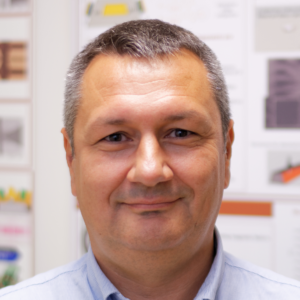Overview
The Magnetic Random Access Memories (MRAM) group develops advanced concepts in this emerging technology. The goal is to realize cells with improved thermal stability, lower power consumption and/or faster switching. Our research covers material stack deposition, nano-fabrication and electrical test evaluation, for applications as standalone memory and non-volatile logic and more recently in neuromorphic computing architectures.
Research directions
Perpendicular Anisotropy Materials
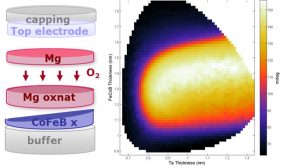
High energy barriers for spin transfer torque (STT) MRAM cells can be achieved with perpendicular anisotropy magnetic tunnel junctions. Solutions for high density MRAM cells to diameters below 20nm require continuous improvements in perpendicular surface anisotropy, while maintaining high TMR properties.
Perpendicular STT MRAM
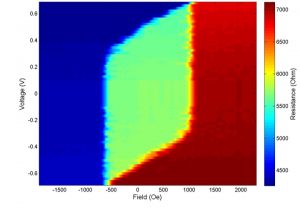
Evaluation of MRAM concepts requires simulation of expected reversal mechanisms and electrical characterization of individual cells. We aim at understanding dynamics of magnetization reversal and the expected impact of stack modifications to explore application specific optimizations.
Nanofabrication Challenges
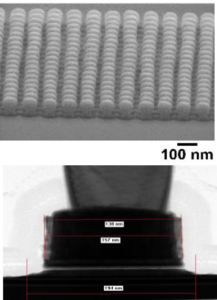
Innovation on dense MRAM using pre-patterned substrates, CMOS integration of multifunctional cells and sub-10nm lateral sizes. Tunnel junction nanofabrication in our platform is essential to evaluate MRAM concepts and performance.
Perpendicular Shape Anisotropy
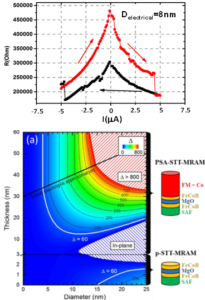
A solution for sub-10nm cell sizes uses high aspect ratios to generate perpendicular shape anisotropy providing scalable retention at the smallest cell sizes. Spin transfer torque switching is possible in these cells, where the reversal dynamics is now under study.
The team
Former members
Post-docs
- Andrey TIMOPHEEV (2014-2017)
- Van Dai NGUYEN (2016-2018)
- J. Ranier Roiz (2015-2016)
- Nikita Strelkov (2016-2019)
PhD
- Luc TILLIE (2015-2018)
- Nicolas PERRISSIN (2015-2018)
- Jyotirmoy CHATTERGEE (2014-2017)
- Hieu Tan NGUYEN (2013-2016)
- Antoine Chavent (2013-2015)
Process Engineers
- Jude GUELFFUCCI (2015-2017)
- Nathalie LAMARD (2016-2017)
- Guillaume LAVAITTE (2015-2016)
Projects
- Samsung SGMI (2014-2017)
- ANR Excalyb (2014-2017)
- Heumem (2015-2018)
- EU-FET Spice (2016-2019)
- EU Great (2016-2019)
- ERC Magical (2015-2020)
Partners
- CEA LETI, Grenoble, France
- Institut NEEL, Grenoble, France
- Crocus Technology, Grenoble, France
- Samsung, San Jose, USA
- Singulus AG, Kahl am Main, Germany
- Aarhus University, Aarhus, Denmark
- Radboud Universiteit, Neijmegen, Netherlands
Recent news
- EMERGING NON-VOLATILE MEMORIES: MAGNETIC AND RESISTIVE TECHNOLOGIES (July 02nd, 2015)
B Dieny In 2010, the International Technology Roadmap for Semiconductors (ITRS) published an assessment of the potential and maturity of selected emerging research on memory technologies. Eight different technologies of non-volatile memories were compared (ferroelectric gate ... - ELECTRICAL MODELING OF STOCHASTIC SPIN TRANSFER TORQUEWRITING INMAGNETIC TUNNEL JUNCTIONS FOR MEMORY AND LOGIC APPLICATIONS (July 02nd, 2015)
Yue Zhang , Weisheng Zhao , Guillaume Prenat , Thibaut Devolder , Jacques-Olivier Klein , Claude Chappert , Bernard Dieny , and Dafiné Ravelosona Magnetic tunnel junctions (MTJ) are considered as one of the most promising ... - COMPARISON OF DISPERSION AND ACTUATION PROPERTIES OF VORTEX AND SYNTHETIC ANTIFERROMAGNETIC PARTICLES FOR BIOTECHNOLOGICAL APPLICATIONS (July 02nd, 2015)
S. Leulmi, H. Joisten, T. Dietsch, C. Iss, M. Morcrette, S. Auffret, P. Sabon, and B. Dieny Magnetic nanoparticles are receiving an increasing interest for various biotechnological applications due to the capability that they offer to ... - DIFFUSIVE MODEL OF CURRENT-IN-PLANE-TUNNELING IN DOUBLE MAGNETIC TUNNEL JUNCTIONS (July 02nd, 2015)
We propose a model that describes current-in-plane tunneling transport in double barrier magnetic tunnel junctions in diffusive regime. Our study shows that specific features appear in double junctions that are described by introducing two typical ... - MAGNETIC RANDOM ACCESS RANDOM ACCESS (July 02nd, 2015)
1 Introduction 2 Magnetic Tunnel Junctions: A Route for CMOS/Magnetism Integration 3 Spin-Transfer Phenomenon 4 Magnetic Random Access Memories (MRAM) 4.1 Stoner-Wolfarth MRAM (SW-MRAM) 4.2 Toggle MRAM 4.3 Spin-Transfer Torque MRAM (STT-MRAM) 4.4 Thermally Assisted MRAM (TA-MRAM) 5 Racetrack Memories







